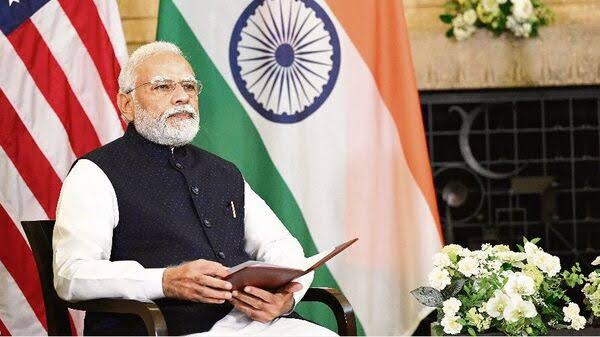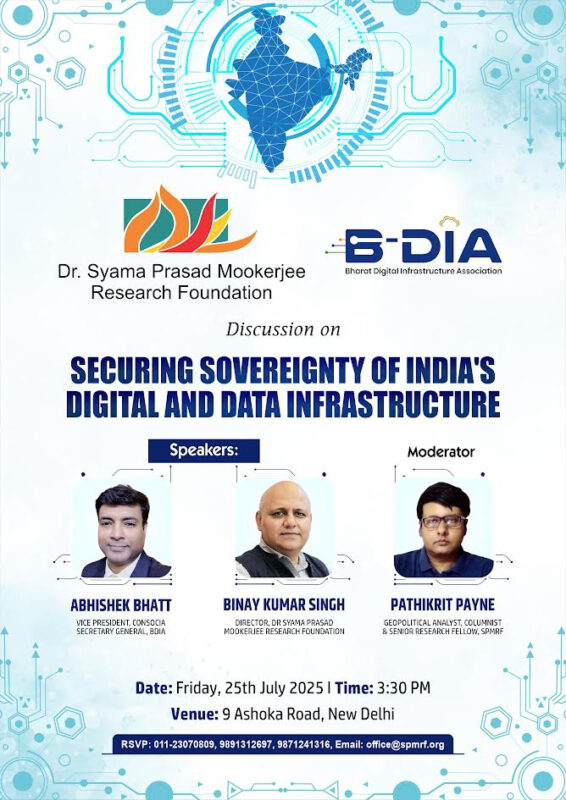In the frigid winter of September, with no one to vouch for him and with all religious organizations disavowing him, Narendra endured the night in the cold until Mr. and Mrs. Hale discovered him at their doorstep. The following day, Mrs. Hale escorted Narendra to the venue, unaware that she was about to become a part of history. That day marked a momentous milestone in the cultural history of Bharat, as Narendranath Dutta, widely known as ‘Swami Vivekananda,’ delivered his speech to the assembled crowd. His words deeply resonated with all those present. Bharat had discovered a savior, a saffron-robed monk wearing a turban, evoking memories of the illustrious era of Hindu civilization. The year was 1893.
In 2013, India was grappling with widespread corruption. Nepotism and favoritism were prevalent, and there seemed to be no anti-incumbency, as stated by the media. However, there were whispers that the Prime Minister face would change. According to the media, the next Prime Minister would be a young, dynamic, and charismatic individual who would symbolize an aspiring India. Preparations were underway, and in September, the BJP led opposition camp engaged in an extensive discussion to find the right candidate for the Lok Sabha polls. They were in need of a prominent figure. Vajpayee Ji and Advani Ji, who had built the party from scratch, were growing old. The media howled, claiming that BJP lacked a strong leader. They even concluded that the era of Hindutva politics was coming to an end. However, in the land of Somnath, the BJP had a resounding response to such media reports: “Narendra will lead us,” echoed throughout the camp.
Narendra Modi served as the Chief Minister of Gujarat for three consecutive terms. The state achieved remarkable outcomes, surpassing the nation’s prevalent growth rates. According to the World Bank Ease of Doing Report, Gujarat was recognized as the top performer. This success in the business sector revitalized the sense of pride among the Gujarati community. The state’s impressive economic performance can be attributed to this rekindling of self-confidence. While Narendra Nath Dutta reminded Hindus of their glorious ancient civilization, Narendra Modi diligently implemented those ideals.
Reclaiming Lost Glories
India, a nation with a predominantly Hindu population, has seen its culture and beliefs spread across the globe as a result of the large number of Indians living in other countries. At the core of Hinduism lies the belief in Bhagvan Sriram.
In 2014, with the advent of the Narendra Modi Government, good governance became a central pillar of the administration. This focus on good governance was seen as the first step towards realizing the concept of Ram Rajya. Bhagvan Ram is revered as a deity in many Southeast Asian countries as well, and this cultural reclamation aims to restore the glory of Bharat. The consecration of Ram Lalla holds immense significance in the history of Bharat and serves as the foundation for the concept of Akhand Bharat, a cultural entity rooted in the Hindu belief system that extends across Asia.
Thanks to the efforts of the Modi Government, this cultural resurgence and its influence has also spread to Africa, Pacific Island nations, Europe, and the Americas. Today, the festival of Diwali, a symbol of our glorious heritage, is celebrated with equal enthusiasm from the White House to Downing Street. The Narendra Modi Government has also revitalized ancient pilgrimage centers, with the Ministry of Tourism providing financial assistance for the development of tourism infrastructure through schemes like Swadesh Darshan and PRASHAD. Under the Swadesh Darshan scheme, the Ministry has sanctioned 76 projects since 2014–15, including 10 projects focused on heritage. The PRASHAD scheme aims to integrate spiritual heritage and promote pilgrimage tourism in the country.
Buddhist, Jain, and Sikh Engagement
The three prominent religions that originated in India, apart from Sanatan Dharma, are Buddhism, Jainism, and Sikhism. These religions, which were born here, incorporated elements of Hinduism in their scriptures and practices. The Guru Granth Sahib contains verses referencing Bhagawan Ram. Buddhism and Jainism have also evolved from the Sanatan philosophical system.
It is the principle of ‘Sarva Dharma Sama Bhava’ or inclusiveness that sets these religions apart and has contributed to their rapid global expansion. Although Jainism, due to its strict doctrines, did not extend beyond the Indian subcontinent, Buddhism and Sikhism experienced significant growth.
However, little effort was made to explore the cultural ties associated with these religions, which originated in our land. The Modi Government recognized the significance of these cultural connections and made substantial investments to harness their full potential. During a period of strained relations with Pakistan, India successfully established the Kartarpur corridor, enabling Sikh pilgrims from both countries to connect with each other. Buddhist outreach was facilitated through the establishment of the Buddhist Circuit and the organization of conferences on Buddhism. Kushinagar, the place where Buddha attained Parinirvana, was developed into a pilgrimage center. Through these initiatives, India was reaching out to other nations that were once part of our ancient and glorious era. The restoration of the ‘Nalanda Connect’ in ancient India was being revitalized to its utmost splendor once again.
Promoting Culture Globally
The 69th Session of the United Nations Assembly witnessed the Prime Minister of India delivering a significant address on June 21, 2014. On that day, he put forth a proposal to celebrate June 21st as International Yoga Day, conveying a clear message to the global community. The overwhelming support of 175 countries for our proposal showcased the influence of Indian culture on the world stage. The importance of preserving traditional medicine systems led to the establishment of the Ayush Mantralaya in November 2014. Presently, 97 out of the 157 countries affiliated with the World Health Organization have developed national policies concerning traditional medicine systems. It is estimated that around 250 million people had participated in the celebrations of International Yoga Day in 2023. The establishment of the Ayush Ministry has also raised awareness, resulting in the introduction of a special visa category called the ‘Ayush Visa’ for individuals seeking treatments in India.
Furthermore, the Ministry of Ayush has signed agreements with 24 countries to foster cooperation in the field of traditional medicine. In 2016, the festival of ‘Navroz’ celebrated by the Parsi community was inscribed on UNESCO’s list of intangible cultural heritage for humanity. The Parsi community has made significant contributions to the development of modern India, despite their declining population. This recognition serves as a tribute to their remarkable cultural and heritage contributions. Over the years, the government has successfully added the Kumbha Mela, the world’s largest religious gathering, the Durga Puja of Bengal, symbolizing women’s empowerment, and the Garba Dance of Gujarat to UNESCO’s list. These achievements demonstrate the government’s unwavering commitment to engaging with all segments of Bharat and emerging as a global cultural superpower. Throughout the past decade, the Modi Government has consistently introduced the world to India’s ideologies, culture, and societal influence.
Also, there has been a significant push to promote Bharatiya culture through the celebration of various festivals. In the financial year 2023-24, the Ministry of Culture increased its annual budget by 12.97% to Rs 3399.65 crores. The Azadi Ka Amrit Mahotsav was celebrated with grandeur nationwide, allowing us to acknowledge the immense contributions of numerous individuals who sacrificed their lives for our country’s freedom. Every region of our country has heroes who laid down their lives for our freedom, but unfortunately, they were overshadowed in the pursuit of glorifying specific individuals and institutions. As per revised estimates, an allocation of Rs 353.82 crores was made for the heroes of our freedom movement. It was an appropriate time for us to repent for neglecting the families of these brave fighters and pushing them into oblivion. This will also encourage further research into our freedom movement in the upcoming year. The budget for autonomous bodies and archaeological survey of India was increased, and sincere efforts were made to repatriate over 238 lost idols back to India, reinstating them in their rightful places. During the nine years of the Modi Government, India successfully rediscovered and reconstructed nearly 40 ancient temples, including the Raghunath temple, Umiyadham temple, Mathura Vrindavan temples, Somnath temple, and many others. In the glorious Hindu era, Sanskrit served as the primary language, uniting communities in ancient India. Recognizing its significance, the Modi government passed the Sanskrit Universities Bill, and the New Educational Policy was formulated to impart knowledge about our illustrious past. These legislative and policy changes have greatly contributed to cultural integration.
Our ancestors, motivated by Narendranath Dutta, valiantly battled against the empire and successfully subdued it. Drawing inspiration from him, we continued the journey of our cultural revival and the exploration of our illustrious past. Narendra Nath Dutta’s endeavors were continued by Narendra Modi, our Prime Minister. Now, it is our turn to derive motivation from our Prime Minister and strive towards achieving the vision of a developed India, Viksit Bharat by 2047.
(Adarsh Kuniyillam is a Parliamentary and Policy Analyst. Views expressed are his own)
(The views expressed are the author's own and do not necessarily reflect the position of the organisation)


